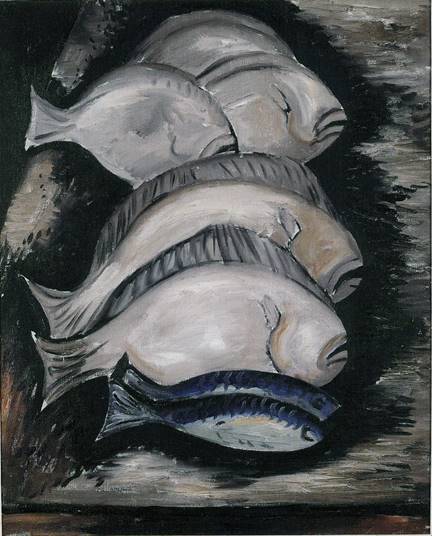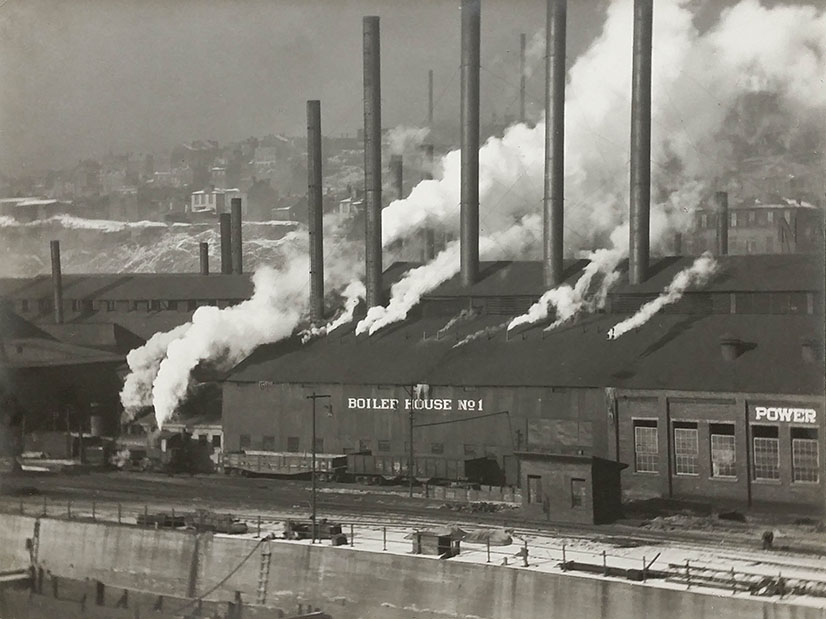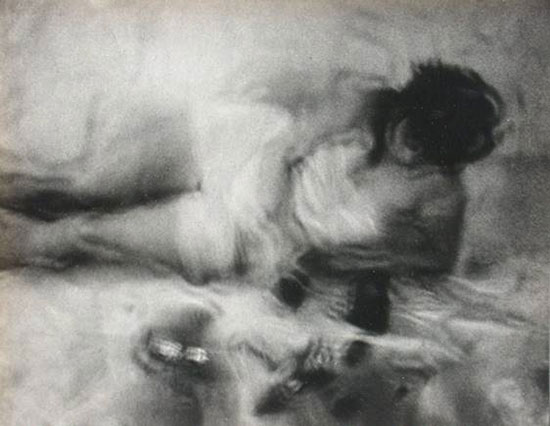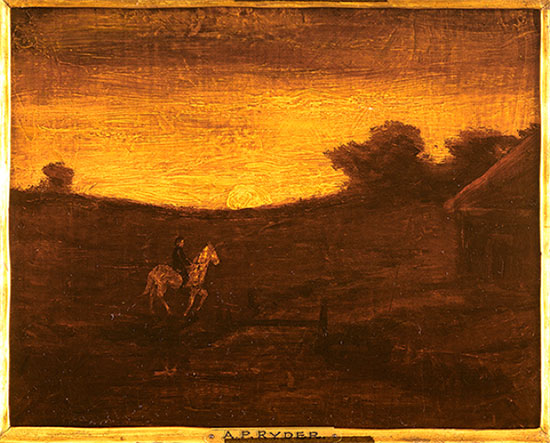The bold and thoughtful premise of Janet Lehr’s provocative “The Triumph of American Modernism” exhibition is laid out right at the beginning on the first wall. Two brooding photographs of Pittsburgh steel mills with smoke billowing lustily from their crisply rhythmic stacks flank a curvy, faintly comic painting of seven fish by Marsden Hartley made in 1924.
.

"Chez Prunier (Still Life with Seven Fish)" by Marsden Hartley c.1924. Oil on canvas, 32 x 25 3/4 inches. Courtesy Janet Lehr Fine Arts.
.
The photos of the mills were taken in 1910 by the American Alvin Langdon Coburn, who, like Henry James, became an expatriate in London and was a friend of George Bernard Shaw. In combination with the Hartley work, they deliver the heavyweight punch of the exhibition, a thoughtful integration of photography, drawing and painting.
.

"Pillars of Smoke, Pittsburgh" by Alvin Langdon Coburn, c. 1910. Platinum print witih silver wash, 8.5 x 10.875 inches. Courtesy Janet Lehr Fine Arts.
.
In addition to the Coburn works—which have an interesting provenance because they are not in the definitive Coburn collection at the George Eastman House in Rochester, NY—one of the photographic gems in the show is a small but radiantly alluring photo of Kike de Montparnasse “underwater” by Man Ray, as smoky as a Mallarmé poem and made all the more delicate by the evocatively buckled paper on which it has managed to swim since it was made in the Jazz Age.
.

"Underwater" by Man Ray, 1928. Still from the film, "Etoile de Mer." Vintage Silver print with hand painting, 4.5 x 5.75 inches. Courtesy Janet Lehr Fine Arts.
.
The leap from photography to painting is a terrific starting point for the historical mission of the show. Similar arguments have been posed regarding 19th century relationships between works on canvas and photography featuring Degas, Renoir and the Impressionists. Beyond this correlation of mediums, arguing about the origins of Modernism, not just in art but in aesthetics, is a blood sport among academics.
Some literary critics push the starting dates back into the 19th century, citing Baudelaire and Whitman well in advance of the usual suspects, T.S. Eliot and James Joyce. And I have known music scholars to pick out the Modernist strains in Beethoven sonatas and Brahms symphonies, both generations ahead of Arnold Schoenberg and Igor Stravinsky.
Because Modernism and abstraction are so firmly linked in art history surveys, the show at Lehr earns special points for its contrarian decision to follow a more mimetic course, linking photography and Precisionism for example, and staying close to the figure. For example, paintings by Ralston Crawford, Niles Spencer and Albert Pinkham Ryder (a terrific pairing with the formidable Hartley, as the Met also discovered in its show at the Breuer) emphasize the delineation of forms, an obvious correspondence with the way in which photographs are read.
.

"Ships Bow" by Ralston Crawford. Oil on canvas. Courtesy of Janet Lehr Fine Arts.
.

"Homeward at Twilight" by Albert Pinkham Ryder. Oil on canvas laid down on panel, 8 x 10 inches. Courtesy of Janet Lehr Fine Art.
.
Two fantastic floral watercolors by Charles Demuth have all the (Teutonic) expressive authenticity of Emil Nolde, with just the American accent sought by the context. The gentle, waxen whiteness of Edwin Dickinson’s Martha (Nude) is a late but welcome entrant to the conversation, and Morgan Russell’s portrait of Cézanne is one of the most conventional paintings of his I have seen (his Synchromism was an American take on Delaunay’s spectral Cubism).
.

"Blue Flowers" by Charles Demuth, c. 1915. Watercolor, 10.82 x 8.12 inches. Courtesy of Janet Lehr Fine Arts.
.

"Cézanne" by Morgan Russell, 1910. Oil on canvas, 15.75 x 13.875. Courtesy Janet Lehr Fine Arts.
.
Abstraction is never far, though. Many of the strongest technical works in the show are from the group that Stieglitz gathered (friends of Demuth) who followed Kandinsky into the “non-objective” worlds of pure color or geometry. The boldest among these is a small but tightly constructed abstract painting by Arthur Dove, Figure 4, made in 1945, its heavy beams of green and red offering a scaffolding for the appreciation of Howard Hodgkin decades later.
The Joseph Stella oil pastel from 1923 has a long plume of ultramarine blue that wonderfully answers the ribbon strokes of a de Kooning charcoal on vellum that hangs a few feet away, facing it, one of those amazing feats of legerdemain that made the Dutchman the envy of his group. The two x marks on the right side are “imposition marks” usually used in the printmaking process to orient images, suggestions (according to the captions on the web site) that de Kooning was preparing to quote these marks in another work, a riveting thought.
This has been a particularly good season for gaining an appreciation of John Graham’s place in the history of Modernism, with an acclaimed exhibition at the Parrish (reviewed here) and three strong works in the Lehr show, including a crayon drawing dashed off in loopy gestures in 1915, a pencil drawing of Elinor Gibson with diabolically black eyes made in 1924, and a forlorn scene, Place Observatoire, made in 1924, which unleashes a blast of molten orange at its core that conjures the elaborate bronze fountain sculpture by Carpeaux made in 1873.
.

"Place Observatoire" by John Graham, 1927. Oil on canvas, 21.25 x 28.75 inches. Courtesy Janet Lehr Fine Arts.
.
This impressive exhibition would have benefited mightily, in my view, from the addition of a catalogue, or at least a wall text and more assiduous group of labels. I recognize the truth of the art-world axiom, “Let the pictures tell the story,” and the central thesis of the exhibition is clearly expressed in the curation. Still, both the novice and the seasoned art lover could have a deeper appreciation for the show as a whole if there were an essay on why these particular artists were so vital to the development of American Modernism.
Thankfully, a press release from the gallery on the exhibition does include this terrific quotation from the innovative Coburn (who gave Stieglitz a run for his money as a pictorialist) that neatly summarizes the story:
“What would our grandfathers have said of the work of Matisse, Stravinsky, and Gertrude Stein? If we are alive to the spirit of our time, it is these moderns who interest us; why should not the camera also throw off the shackles of conventional representation and attempt something fresh and untried? Why should not its subtle rapidity be utilized to study movement? Why not repeated successive exposures of an object in motion on the same plate? Why should not perspective be studied from angles hitherto neglected or unobserved? Think of the joys of doing something which it would be impossible to classify, or to tell which was the top and which the bottom?”
__________________________
BASIC FACTS: “The Triumph of American Modernism” is on view August 20 to September 20, 2017 at Janet Lehr Fine Arts, 68 Park Place Passage, East Hampton, NY 11937. Janetlehrinc.com
__________________________
Copyright 2017 Hamptons Art Hub LLC. All rights reserved.

Ah! An opportunity to see a Man Ray print, and a particularly interesting one, too!
Love the suggestion of a catalogue or wall text. Too often we are expected to simply ‘know’. The exhibitors do themselves and the public a disservice by missing these chances to elucidate those interested but lacking the formal art education needed to fully understand the intent of the curator.